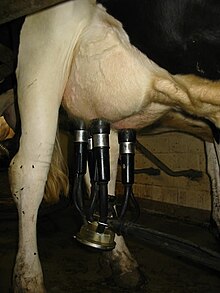milking
Milking is called the activity in which milk is obtained from an udder . Most animals such as cows , goats and sheep are milked. Milking was traditionally done by hand; today, at least in industrialized countries, cows are practically only milked by machine .
General
Milking simulates the suckling of a young animal on the mother's udder. Therefore, a cow must have calved before giving milk for about 300 days. A cow is usually productive for five years. How often an animal has to be milked a day depends on the breed , the milk yield (see lactation curve ) and the feeding of the animal. Cows are usually milked in the morning and in the evening, and dry for a few weeks before the birth of a new calf.
To empty the udder, the suckling of the calf or other stimuli to which the cow is conditioned must release the hormone oxytocin , which is formed in her pituitary gland , in her bloodstream . The oxytocin causes the milk to be poured into the milk cistern of the udder for five to eight minutes, from where it can be sucked off by the milking machine or pressed out through the fingers during manual milking.
The composition of milk changes in the course of lactation, in particular the content of fat, protein and table salt increases. When the milk is finally no longer fit for the road, the cow is called old milking. That is why a dairy cow has to calve at regular intervals. In practice, a cow is calved once a year. Before calving, she is not milked for around two months, so the usable lactation period lasts around 300 days.
Manual milking techniques
Milking an animal by hand requires some practice, especially when careful milking speed is used. The milker sits on a milking stool at the side of the animal. Then the milker grips the teats by the roots by closing his thumb and forefinger in a ring and the remaining fingers one after the other forming a fist. Experienced people can milk up to one liter of milk per minute on goats. With this method, the milk is collected in a milking bucket. There are different grip techniques, none of which are clearly superior to the others.
The milk is bound to the tissue in the udder. Only a suitable stimulation (the preparation) allows the milk to shoot into the milk ducts before milking. The shooting in is triggered by the hormone oxytocin . The effect only lasts for about 7 to 10 minutes, so you have to milk quickly. The stress hormone adrenaline inhibits the effect of ocytocin, so it is important that the cow is not exposed to unpleasant stimuli or frightened during milking. Noise and vibrations in the cowshed are a burden both to the animal and the milker. If the stressful situation persists, errors in the handling of the milking machine can creep in. This in turn can lead to udder infections, which affects the quality of the milk.
One in the ethnographic -reported literature from many countries process is the cow blowing (to German cow blowing ) in which by vigorous blowing air into the vagina - sometimes in the anus is trying to reach the cow improved milk yield -. The physiological effect of these practices is unclear.
Milking machines
When milking machines are used, so-called teat cups are placed around each teat of the udder. Then the machine begins to suck and massage every second, driven by a vacuum pump and the pulsator. The milk is withdrawn here by the negative pressure in the teat cup interior. If the machine is correctly adjusted and maintained, the animal does not feel any pain during milking. There are two different milking methods: synchronous and alternating. All teat cups pulsate at the same time and alternate in pairs with the alternating cycle. Common-mode milking is preferable because it prevents infections between different udder quarters and provides significantly better relief. It is important to ensure that the main milk tube is led upwards, although opinions differ. Another advantage of the common-mode process is a significantly better degree of milking. The milk is immediately filled into the appropriate containers via hoses and fed to the cooling system. One undesirable effect here is blind milking .
Web links
Individual evidence
- ↑ Handbook of Milk and Dairy Technology , Ed .: Tetra Pak Processing GmbH, Verlag Th. Mann, Gelsenkirchen, 2003
- ↑ a b Kästli, Flückiger, Schällibaum: Das Melken, Grafino Bern, 8th edition (undated, approx. 1980)
- ↑ Agripedia ( Memento of the original from March 4, 2016 in the Internet Archive ) Info: The archive link was inserted automatically and has not yet been checked. Please check the original and archive link according to the instructions and then remove this notice.
- ↑ "Less stress for the cow in the workplace" ( Memento of the original from October 23, 2014 in the Internet Archive ) Info: The archive link was inserted automatically and has not yet been checked. Please check the original and archive link according to the instructions and then remove this notice. , Agroscope ART, media release from February 22, 2010.
- ^ Clancy, Shae (1999): Cattle In Early Ireland Celtic Well.



